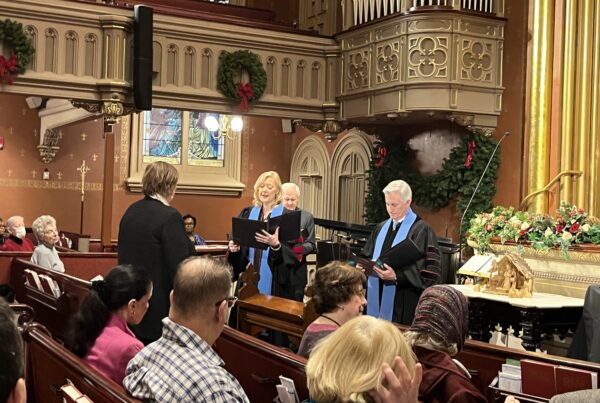Considering how to start something new in an entrenched institution—say, about a hundred years old—is not a new idea. Here are a few tips for getting started, challenges you might encounter, and the kinds of people who are more likely to be successful at starting something new.
This material was originally recorded as part of the Renovations Project. It has been lightly edited and condensed for clarity.
Start with the “W” questions
When thinking about starting something new, the first thing that I do is ask the “W” questions: Why are we doing this? Who are we doing this for? What is the primary motivation to do this new thing? Just because you think it’s a good idea doesn’t mean that you can build enough traction to keep it. If you answer those questions, this will provide a benefit to all of your constituents. This is something that will help make your jobs easier. This is something that provides incredible value to your community.
If you begin first with the why, then two things can happen. The first is this: if you don’t really have good answers for it, you can check in with your people, those who you serve. You can go to those you serve and say, “We’re thinking about doing this thing. What are your thoughts? Your honest thoughts. Give me your honest feedback on it.” And then the second part is, once you have that, you have the why, then we have to think about how we would do it.
Related: How your church can engage and support your community
I think of this in a very simple way. For example, let’s say you wanted somebody to drink more water. There are two things that I would always think of right away. The first would be that we have to create more access and easy access. If you want people to drink more water, then we need to have a water cooler anywhere people are. We have to create access. The other part is that you have to let people know that you have a message to say—this is the why. Why should they want this water? Because it’s fantastic, it keeps you alive, it’s wet, or it’s totally neutral.
In that context, if you create the messaging and what the value is for people and then create access, you increase the likelihood that people will do it. In so many organizations, there are so many fantastic ideas, but if you don’t let people know about what’s available, or you don’t create multiple gateways to it, then here’s this awesome idea that gets underutilized.
Challenges to starting something new
One of the most frequently encountered challenges for starting something new is that when you’re starting to give your pitch, the people already have an attitude or belief that it won’t work. Here’s the group that’s going to be responsible for implementation, but already you will have people who will tick off all the reasons why it won’t be successful.
The biggest way to overcome that is having proof within the organization. Let’s say that you work for a hospital, and somebody says, “Well, in other healthcare organizations, here’s this thing that they did, and it had these benefits.” But somebody responds, “But that’s not our organization. That works in Europe, but that won’t work here.”
The thing that tends to increase receptivity is when you just try it. Try it a little bit. For example, we’ve got a community college that has 14,000 students. What if we just try it with 20? If you try it with 20, and you get the outcomes that you want to see, then we’re talking. This is our population. This is what they say is the value. And once you have that, then you can think about scale. Part of it is that people want to know if you have the proof that this works right here, within our organizational context. Because if you do, it’s hard to argue otherwise. You’re not dismissive of someone else’s data. This is your data. This is the experience of your constituents.
Related: Experimenting on the margins: my journey into adaptive leadership
Two kinds of people who can get things started
Every organization has within it people who have two kinds of enduring talent. One of those is influencing. And the other is relationship building. The people who have the talent of relationship building have the capacity to be able to say, “I’ve done the homework on this. I think that this is an incredible opportunity.” Because of the relationship, there is trust that’s already created between them. If my friend who cares about me—and I care about her—says that this is something that we should try, I trust her. The relationship’s there.
Related: Why building trust in God and each other is crucial for hospitality
The other people just use good, old-fashioned influence. These people have the gift of gab. People who can say and do things that move people to action. That has worked since we were on the playground in elementary school. This is somebody who has a voice, somebody who is charismatic, somebody who demonstrates that they just have something about them that can get people to go. If you leverage those two things, whoever is in your circle already is going to be more receptive to starting something new.
Another part to starting something new is asking questions in an analytical way. Questions like: what’s the worst thing that could happen? What are the risks? If we try this thing for three months with this population, what’s the worst thing that could happen? Is this manageable? Could we live with this? What’s the cost if we don’t do anything? When we’re talking about something that provides value and benefit, that contributes to somebody’s wellbeing, in absence of us doing anything, what’s the cost there?
The start is the big thing. Once you’ve done your homework, you can change and alter course after that. But if you sit back and you’re always waiting for the right time, there’s a cost there.

Renew your church’s imagination for ministry
The Renovations Project helps leaders learn, together.
- Thought-provoking masterclasses
- Personalized coaching
- Immersive visit to a ministry innovation hub
- Ministry innovation grants up to $5,000

Ken Barr Jr.
Ken Barr Jr. is a licensed professional counselor, career coach, and organizational consultant. As Michigan’s first Gallup-certified Strengths coach, he has helped more than 20,000 people begin their StrengthsFinder journey. Ken participated in listening sessions about innovation hosted by the Reformed Church in America.



